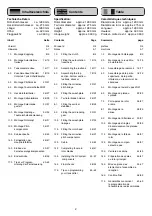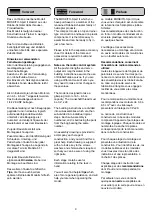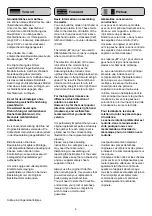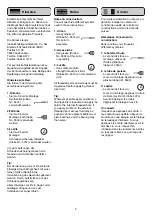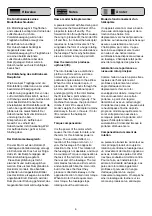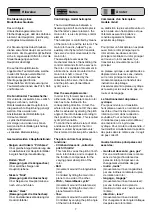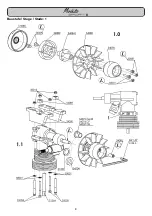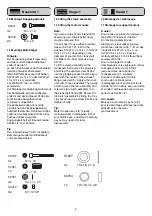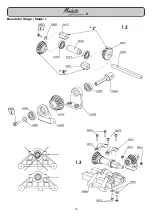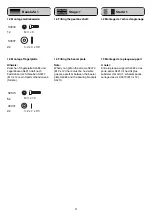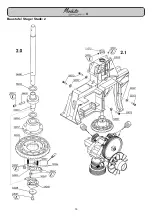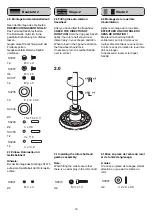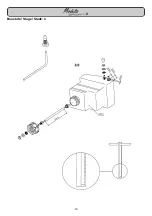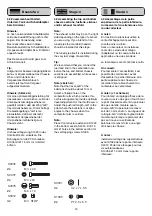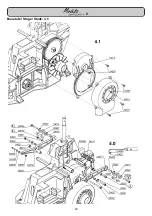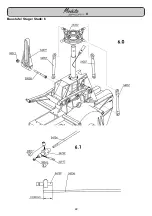
7
Hinweise
Notes
À noter
Die Steuerung eines
Modellhubschraubers
Das wichtigste
Unterscheidungsmerkmal zum
Flächenflugzeug ist, daß das Antriebs-
element, der Hauptrotor, gleichzeitig
wichtigstes Steuerelement ist.
Zur Steuerung des Hubschraubers
dienen sowohl der Haupt- als auch der
Heckrotor. Am Hauptrotorkopf befindet
sich ein sogenannter Hilfsrotor, der die
Steuerbewegungen auf den
Hauptrotor überträgt
Die auf der Hauptrotorwelle
angebrachte Taumelscheibe, welche
in allen Richtungen verstellbar ist,
dient dabei als mechanisches
Übertragungsglied für die
Steuerbefehle. Zur Ansteuerung der
Taumelscheibe dienen das Pitch, Roll-
und Nickservo.
Die Funktion der Taumelscheibe:
Um vorwärts, rückwärts, bzw. seitlich
fliegen zu können, muß die
Rotorkreisebene des Hauptrotors in
die gewünschte Flugrichtung geneigt
werden. Dazu werden die
Anstellwinkel der Rotorblätter pro
Umlauf verändert.
= zyklische Blattverstellung.
Um steigen und sinken zu können
werden die Rotorblätter gleichsinnig
angesteuert.
= kollektive Blattverstellung
Gesteuert werden 4 Hauptfunktionen:
- Steigen und Sinken: “Pitch,Gas“
Über gleichsinnige Veränderung des
Anstellwinkels der Hauptrotorblätter
bei gleichzeitiger Gasänderung.
- Rollen: “Roll“
(Bewegung um die Längsachse)
Über seitliches Neigen der
Hauptrotorebene.
- Nicken: “Nick“
(Bewegung um die Querachse):
Über Neigen der Hauptrotorebene
nach vorn und hinten.
- Gieren: “Heck“
(Bewegung um die Hochachse):
Über Anstellwinkelveränderung der
Heckrotorblätter
Controlling a model helicopter
The crucial difference between a
fixed-wing aircraft and a helicopter is
that the latter‘s power element - the
main rotor - is also its primary control
element.
The helicopter is controlled by means
of the main rotor and the tail rotor. The
main rotor head is „helped“ by an
auxiliary rotor flybar which transmits
the servos‘ control movements to the
main rotor.
The swashplate serves as the
mechanical means of transmitting the
control commands from the servos to
the rotor. It is capable of movement in
all directions, and is mounted on the
main rotor shaft, or mast. The
swashplate is controlled by the
collective pitch servo, the roll servo
and the pitch-axis (forward/back
cyclic) servo.
How the swashplate works:
In order to fly forward, back and to
either side, the helicopter‘s main rotor
disc has to be inclined in the
corresponding direction. In fact, the
whole rotor disc does not tilt; the same
effect is achieved by altering the pitch
angle of the rotor blades according to
their position on the disc. This is called
cyclic pitch variation.
To control the machine‘s rate of climb
and descent the pitch of the rotor
blades is varied by equal amounts;
this is termed collective pitch variation.
The pilot controls four primary
functions:
- Climb and descent: „collective
pitch / throttle“
This function varies the pitch of both
main rotor blades, and is coupled to
the throttle to compensate for the
varying power absorption of the
rotor.
- Roll:
(movement around the longitudinal
axis)
Controlled by tilting the main rotor
plane to one side or the other.
- Pitch: „forward/back cyclic“
(movement around the lateral axis)
Controlled by tilting the main rotor
plane forward or back.
- Yaw:
(movement around the vertical axis)
Controlled by varying the pitch angle
of the tail rotor blades.
Commande d‘un hélicoptère
modèle réduit
La distinction la plus sensible entre un
avion à aile et un hélicoptère est que
l‘élément assurant la portance
constitue également l‘élément
essentiel de pilotage.
Pour piloter un hélicoptère on exploite
aussi bien le rotor principal que le
rotor arrière. Au-dessus du rotor
principal et solidaire du rotor principal
se trouve un „rotor auxiliaire“ qui
transmet les mouvements au rotor
principal.
Le plateau cyclique, susceptible de se
déplacer dans tous les sens, installé
sur le rotor principal constitue le
module mécanique de transfert des
instructions de pilotage.
L‘asservissement du plateau cyclique
est assuré par les servos de pas, de
roulis et de tangage.
Le fonctionnement du plateau
cyclique:
Pour pouvoir voler en translation
horizontale en avant, en arrière et sur
les côtés, il faut incliner le plan de
rotation du rotor dans la direction
souhaitée. Pour ce faire, l‘angle
d‘incidence des pales est modifié sur
une révolution. Il s‘agit du pas
cyclique. Pour monter ou descendre, il
faut modifier simultanément la position
des pales dans le même sens. Il s‘agit
du pas collectif.
Quatre fonctions principales sont
asservies:
- montée et descente: „pas, gaz“
Par une modification dans le même
sens de l‘angle d‘incidence des
pales du rotor principal avec un
changement simultané des gaz;
- roulis: „roulis“
(mouvement sur l‘axe longitudinal)
par une inclinaison latérale du plan
de rotation du rotor;
- tangage: „tangage“
(mouvement sur l‘axe transversal):
par une inclinaison du plan de
rotation du rotor vers l‘avant ou vers
l‘arrière;
- direction: „lacet“
(mouvement sur l‘axe de lacet)
Par changement de l‘angle d‘attaque
des pales du rotor arrière.
Summary of Contents for Moskito Sport II
Page 1: ...S 2884 II ...
Page 8: ...Baustufe Stage Stade 1 8 II S1393 ...
Page 10: ...Baustufe Stage Stade 1 10 II ...
Page 12: ...Baustufe Stage Stade 1 12 II ...
Page 14: ...Baustufe Stage Stade 2 14 II ...
Page 16: ...Baustufe Stage Stade 3 16 II ...
Page 18: ...Baustufe Stage Stade 4 18 II ...
Page 20: ...Baustufe Stage Stade 4 5 20 II ...
Page 22: ...Baustufe Stage Stade 6 22 II ...
Page 26: ...Baustufe Stage Stade 7 26 II ...
Page 28: ...Baustufe Stage Stade 7 8 28 II ...
Page 30: ...Baustufe Stage Stade 8 9 30 II ...
Page 32: ...Baustufe Stage Stade 10 32 II ...
Page 34: ...Baustufe Stage Stade 10 34 II ...
Page 36: ...Baustufe Stage Stade 11 12 36 II ...
Page 38: ...Baustufe Stage Stade 12 38 II S4536 ...
Page 40: ...Baustufe Stage Stade 12 40 II ...
Page 42: ...Baustufe Stage Stade 12 42 II ...
Page 46: ...Baustufe Stage Stade 14 46 6 4 1 2 3 5 7 8 9 11 mm 14 0 II S3879 ...
Page 48: ...48 Baustufe Stage Stade 14 P E N C G C G C G TAPE A 14 2 14 1 II ...
Page 50: ...50 Baustufe Stage Stade 15 15 A II ...
Page 56: ...56 Baustufe Stage Stade 15 HB Re 9 0 HA Li Re 15 3 HA 11 mm HB 20 mm II ...


